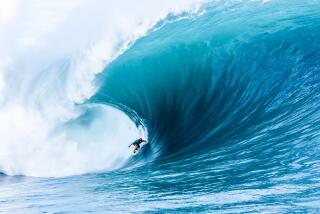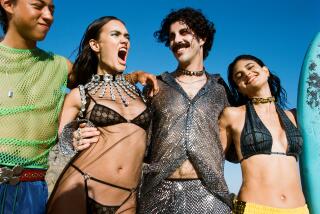Ricky Grigg, oceanographer and top-ranked big-wave surfer, dies at 77
- Share via
It was just after a January storm in 1953, and the waves were epic.
With other adrenaline-addled young surfers, 16-year-old Ricky Grigg caravaned up the coast from Santa Monica to Rincon, just beyond Ventura. Racing with his board into the roar of mountainous breakers, he had a heart-pounding epiphany: This was more than a sport, and the ocean was more than a playground.
“It was like discovering your destiny,” he told The Times years later.
Within a few years, he was shooting down the colossal waves off Oahu’s North Shore. In the 1960s, he was the world’s top-ranked big-wave surfer as well as a fledgling oceanographer who spent 15 days submerged off La Jolla in an experimental capsule called Sealab II. Over the next decades, he explored undersea volcanoes and pristine colonies of coral, developing new insights on the Hawaiian islands’ explosive history and waterlogged future.
Grigg, a celebrated surfing pioneer whose scientific work confirmed one of Charles Darwin’s theories about the origin of tropical islands, died May 21 at his home in Honolulu. He was 77.
Diagnosed with throat cancer in 2003, Grigg died of pneumonia, his wife, Maria, told The Times.
As a surfer, Grigg was known for exuberantly raising his arms over his head at points during his ride. In a February interview with surf historian Matt Warshaw, he said he picked up the move as a teenager on a trip to Hawaii and brought it back to the beaches of Malibu.
“It became such a hot item,” he said. “Even on the land, it was just something you would do while you were standing there, maybe watching somebody else surf. Or anytime, really. It was just a ‘surfer’ thing to do.”
Grigg had “a classic style,” said Fred Hemmings, a former world champion surfer who went on to become a Hawaii state legislator. “He stood erect and his lines were long and clean. I was a half-generation behind him and he was one of my heroes.”
Grigg appeared in more than a dozen surf movies, including “Slippery When Wet” (1958) and “Gun Ho!” (1963). He appeared in a Dewar’s scotch ad, wearing his diving gear, and in 1964 was Yvette Mimieux’s surfing coach for an episode of the TV drama “Dr. Kildare.”
The star had to learn “not just how to ride the big waves but how to convulse her 110 pretty pounds in a realistic imitation of an epileptic seizure while riding them,” Life magazine noted.
In 1967, Grigg mastered the 18-foot waves off Oahu’s Sunset Beach and took first place at the Duke Kahanamoku Invitational Surfing Championship — an elite contest hosted by the father of modern surfing. The previous day, the doctoral candidate had arrived from the mainland “pale and bookish,” Surfing magazine said at the time.
The championship carried no cash prize but Kahanamoku paid Grigg, clad in a flowered aloha shirt, a lasting compliment: “Ricky, you really understand the ocean.”
“At that moment,” Grigg later said, “I felt my strategy of life — of surfing, of oceanography — all come together.”
Born in Los Angeles on April 11, 1937, Richard Wyman Grigg and his sister Robin, who also became a top surfer, were raised by their mother in a Santa Monica beach house once occupied by the actress Mary Pickford. Their parents had divorced and their grandfather purchased the rundown home.
Grigg started surfing at 9 and, as a boy, dived for lobsters that he sold on the beach. At 11, he lost his spleen when he was speared by his surfboard. At 18, he won the first Catalina-to-Manhattan Beach paddleboard race, spanning 32 miles in the open ocean.
Jumping off the Santa Monica pier for fun, Grigg was an occasional pain in the neck to lifeguards until he became one himself. On the beach, he befriended Buzzy Trent, a lifeguard who was among the first of the tough California kids to tackle the big waves in Hawaii.
Grigg later likened Trent to a surrogate father. “In many ways, my dreams were copies of his dreams,” he told an interviewer.
Urged by his mother, Grigg attended Santa Monica College and received a bachelor’s degree in biology from Stanford University — a convenient drive to surf breaks in Santa Cruz. He later received a master’s degree in zoology from the University of Hawaii.
“It took three years,” he told People magazine in 1978, “two of them surfing.”
As a graduate student at the Scripps Institution of Oceanography in La Jolla, Grigg participated in an experiment that tested the prolonged effects of extreme depth on the human body. One of the other crewmen on Sealab II, a project sponsored by the Navy and NASA, was astronaut Scott Carpenter.
Grigg received his doctorate in 1970 and started teaching at the University of Hawaii. He retired in 2006.
Much of his research centered around the atolls and submerged islands of the Hawaiian-Emperor chain, an archipelago extending nearly 4,000 nautical miles into the Pacific. At its northwest reaches, he discovered the “Darwin Point” — a latitude at which, for various reasons, the growth of coral colonies slows and the volcanic islands built upon them start to “drown.”
As for the familiar Hawaiian islands of palms and luaus, they’re moving, with the tectonic plate beneath them, ever so slowly toward the northwest. At a rate of less than four inches per year, submersion is expected in 24 million years.
To measure the growth of coral in a vast ocean realm and get a sense of islands rising and sinking in a slow, ancient dance, Grigg organized dozens of researchers in airplanes, boats and submersibles. Their study, which took five years, was the first to probe the remote reefs, said one of his collaborators, University of Hawaii oceanographer Steve Dollar.
Grigg also explored volcanic activity beneath the waters off Hawaii’s Big Island. In 1971, he and Dollar dived into a sea steaming with molten lava from the Mauna Ulu volcano. Dodging a layer of scalding water and streams of cascading lava, they came upon “a twisting, ropy tangle of exploding volcanic debris winding downslope like a dying dragon.”
“We decided to collect a couple of samples, take a dozen or so quick pictures and then get the hell out of there,” Grigg wrote in his 2012 book, “In the Beginning: Archipelago, The Origin and Discovery of the Hawaiian Islands.” They were the first divers in history to witness such a spectacle, he said.
The data gathered by Grigg and his colleagues helped establish in 2006 the Papahanaumokuakea Marine National Monument, a 1,200-nautical-mile-long stretch of ocean and tiny atolls whose total area is larger than that of all the U.S. national parks combined.
In addition to his wife, Grigg’s survivors include daughters Romy and Raina, and Carol Allen; stepson Mark Monroe and stepdaughter Juliana Chaize; and three grandsons. His older sister, Robin Grigg Smith — who, according to the Encyclopedia of Surfing, was at one point California’s best female surfer — died in 2008.
More to Read
Start your day right
Sign up for Essential California for the L.A. Times biggest news, features and recommendations in your inbox six days a week.
You may occasionally receive promotional content from the Los Angeles Times.







